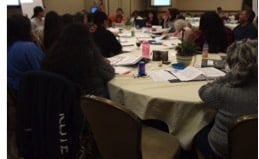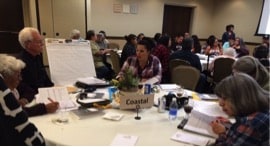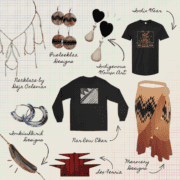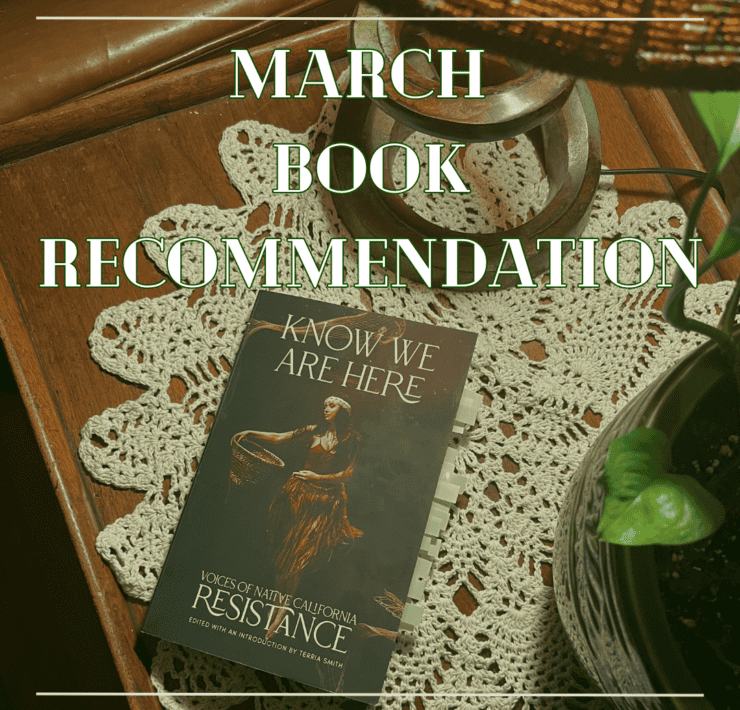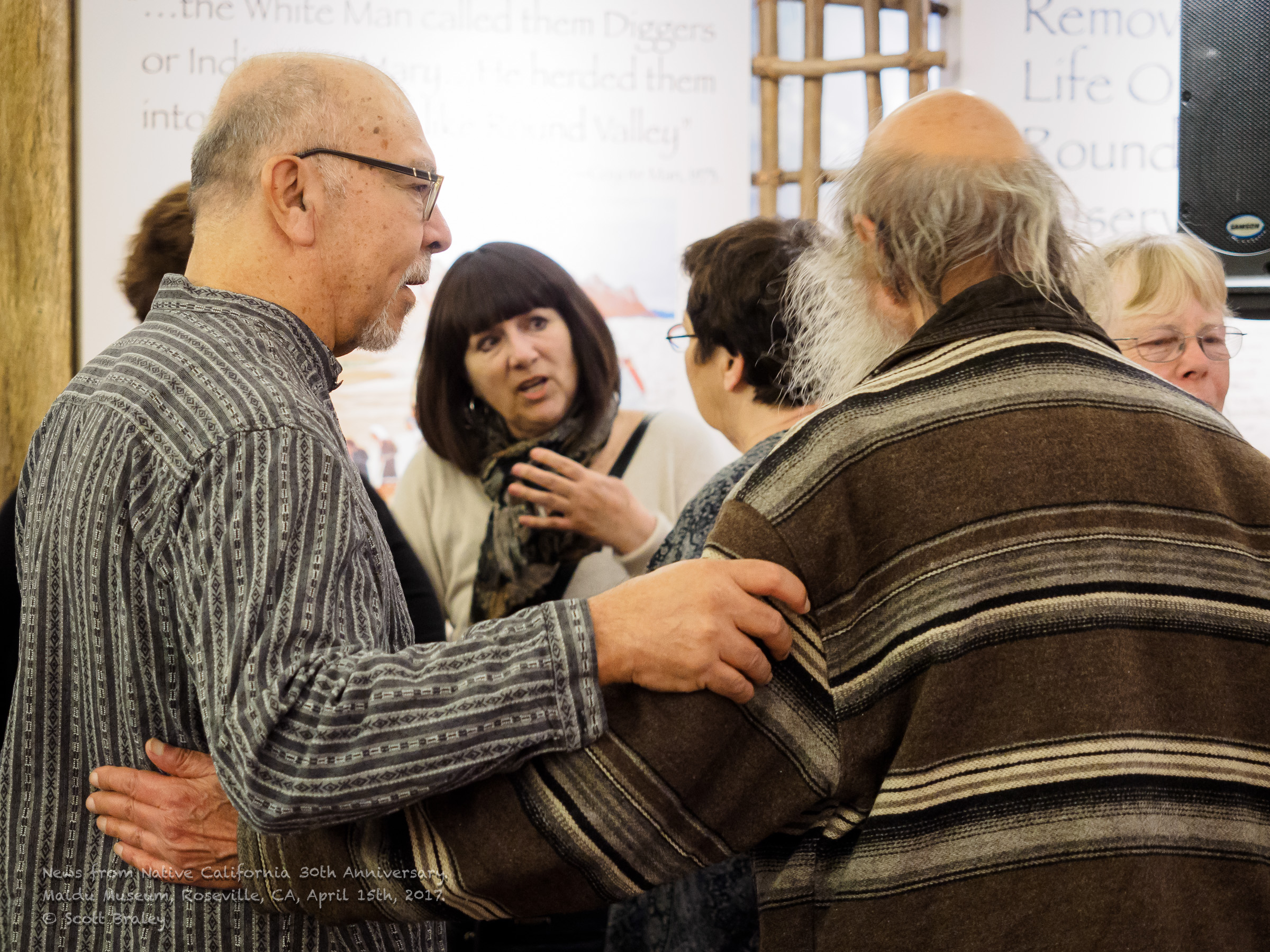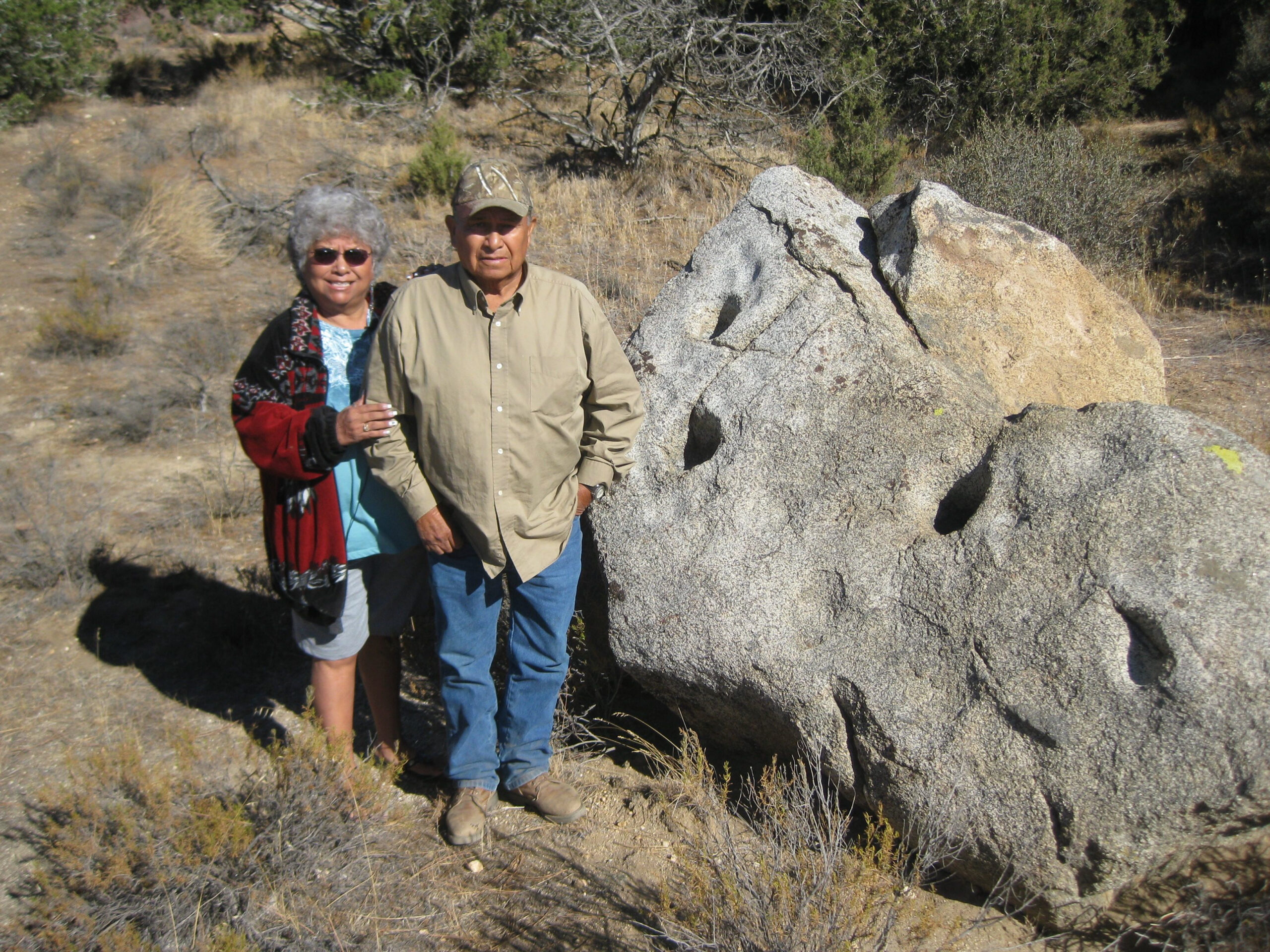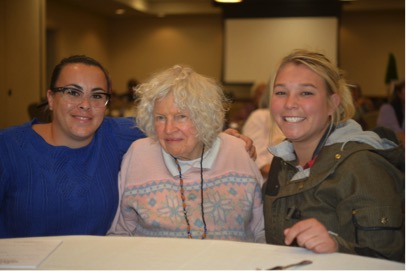
All Miwok Language Symposium
Written by Candra Neff
The 2nd Annual All Miwok Language Symposium was held November 3rd through 5th at the Black Oak Casino Resort Hotel in Tuolumne, California. The Tuolumne Band of Me-Wuk Indians hosted the event. Sponsors included Jackson Rancheria, Shingle Springs Rancheria, United Auburn Indian Community and Wilton Rancheria. Miwok people attended from all over Central California. We were fortunate to have Catherine Callaghan, travel from Columbus, Ohio, to be our guest speaker this year.
Catherine was born in 1931 and is 84 years young. She grew up in Brentwood, California and after graduating from high school, attended U.C. Berkeley where she received a degree in Mathematics. Looking for a graduate program at Berkeley she decided to enter into the field of linguistics.
In 1953, the Survey of California Indian languages was formally established with Mary Haas as director of the newly created department of linguistics. A graduate program in linguistics was developed and students were expected to make a commitment to a long-term study of a particular language. Students were encouraged to work on California languages, (Golla, Victor, Cal. Indian Languages pg. 53-54). Under the direction of Mary R. Haas, in 1956, Catherine Callaghan was sent to meet with Mrs. Alma Grace from San Francisco, who identified herself as a Pomo speaker, to document the Pomo language. She asked Mrs. Grace how to say water. Mrs. Grace said, “Kíik”. Then she asked her, how to say mountain. Mrs. Grace said, “Páwih.” She asked Mrs. Grace many more words, and with her notebook in hand, Catherine brought back this information to Berkeley. At Berkeley she looked up the words in documented works and found the word for water in Pomo was “ka” or “xa”; the word for mountain was “dano”. After some more research, she discovered that Mrs. Grace was speaking Lake Miwok! Catherine then went on to document Lake Miwok, do her dissertation in it and write A Grammar of The Lake Miwok Language that was published in 1963. She then started work on the Lake Miwok Dictionary, which was published in 1965. She got hired at Ohio State University the same year. She inherited Coast (Bodega), Plains, and Northern Sierra Miwok languages by default because no one else was working on them. She would come home summers and at Christmas to work on these languages. Her Bodega Miwok Dictionary was published in 1970, her Plains Miwok Dictionary was published in 1984, and her Northern Sierra Miwok Dictionary was published in 1987 (all were published by University of California Press). Her latest book, Proto Utian Grammar and Dictionary, was published in 2014 (De Gruyter Mouton). Her hope is that her work will help in revitalizing the Miwok language.

The conference was a 3-day event. The first day, Tuesday, was actually in the evening where everyone got together to meet and greet each other. Carlos Geisdorff from the Tuolumne Me-Wuk Language Program brought two slide presentations: Wel:a: Wuke:y (Theft of Fire) and ’Utet:im Ṭele:liy (We Will Give an Acorn Dinner). Melissa Leal, from Wilton Rancheria, presented the You-Tube video, “Miwok Pride”, created through their youth program.

The symposium was an all day event on Wednesday and went into the evening with cultural sharing. L. Frank Manriquez, Native California Indian artist and language advocate, was the M.C. She did an amazing job, mixing humor with the importance of language and culture. Catherine Callaghan was the keynote speaker. Her talk was entitled “ The Education of A Linguist”. We were excited to listen to Catherine’s experiences as a linguist and her expertise in the Miwok language. Catherine was very happy to be at the symposium around so many people interested in her work and revitalizing their language.
Leanne Hinton, professor emerita of linguistics at the University of California at Berkeley, was next. She spoke about “What Counts as Success in Language Revitalization.” In her abstract, she wrote, “The notion of what counts as success is diverse and individual, and always with changing goals, as people learn more and go step by step toward deeper and widening efforts. The goal might be gathering information on the language, or making a phrasebook or dictionary; it might be one person becoming conversationally fluent; it might be a family using the language at home; it might be working toward a community of people who can use the language with each other. Language revitalization might take multiple generations, so the word ‘success’ itself is better phrased as an on-going process- that a person or a community is ‘being successful’ at any point in time in their efforts toward their goals, rather than reaching an endpoint- for the effort must never stop, in a land were English is the dominant and dominating language”.
After lunch, Catherine Callaghan presented “The Sounds of Miwok”. She pronounced all of the sounds in the Miwok language and gave examples of each sound. After this presentation, everyone broke into smaller language groups to work with a linguist to help understand their dictionary. The groups were Coast, Central Sierra, Southern Sierra and Northern Sierra Miwok. There were a few Plains people and Catherine agreed to work with them one-on-one at a different time.
Northern Sierra Miwok was by far the largest group! Catherine Callaghan, with the help of Suzanne Wash, led this group. Richard Applegate led the Coast Miwok group. Sheri Tatsch led the Central Sierra Miwok Group, and Carly Tex, with the help of Leanne Hinton, led the Southern Sierra Miwok group. Everyone was assigned to look up and understand the pronunciation of the numbers one through ten. At the end of the time, each group assigned one or two representatives, and they presented their work.
Examples of numbers from different language groups:
| English | Coast | Central | Northern | Southern |
| Callaghan | Freeland/Broadbent | Callaghan | Broadbent | |
| One | kénne’
|
kéŋ·e’
|
lútti’
|
kéŋ·e’
|
| Nine | ‘únnutas
|
wo’é’
|
wo’é’
|
‘él·iwa’ |
After the group work, Nakia Zavalla, Cultural Director of the Santa Ynez Band of Chumash Indians, presented “California Teaching Credential – American Indian Language and Culture.” She talked about what is required from the state of California to get a Language and Culture Credential. After dinner, there was cultural sharing. Many people brought stories and songs from their communities.
On Thursday the day began with Sheri Tatsch, Ph.D., Indigenous Language Revitalization Consultant, talking about “Creating Teacher and Games Manuals”. After her talk everyone had a choice to play a game at different areas of the room or outside with Carlos Geisdorff. Richard Applegate showed people Lexique Pro for anyone interested. Games included Hune:ma’ (Go Fish), Yolol:i Yul:a’ Chiṭiṭ:i Yul:a’ (Red Light-Green Light), Hung:u’, Hung:u’ (Wolf, Wolf), Na’acha (Ten), Swat the Numbers, a counting game and drawing a picture game.
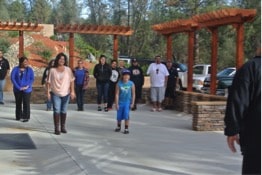
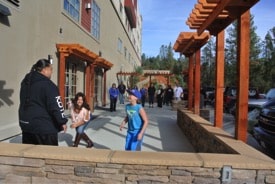
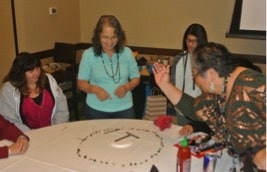

After games, Gordon Bussell, Hupa Language Program Coordinator, spoke about ”The Importance of Language and Culture to Sovereignty”. Then Joseph Arthur, the director of the California Indian License Plate Initiative, presented “Technology and Language”.
After lunch Phyllis Montgomery, a Tuolumne Me-Wuk Tribal elder, spoke about why the language was lost at Tuolumne. In earlier times, many of the people from the tribe were sent to Indian boarding school, including her older siblings. As her brother Sonny Hendricks stated in 2005, “Up until the 1950s the Central Sierra Miwok language was spoken fluently by a majority of the Elders of the Tribe. Those Elders, however, were part of about two generations between about 1890 and 1930 who, as young children, were forcibly taken away from their families at a very early age and were sent to government Indian Schools. This was an attempt by the federal government to assimilate them into the non-Indian society and remove all traces of Indian-ness from them…” (https://www.mewuk.com/cultural/language_preservation.htm).

At the end of the symposium there was a question and answer panel. One question, “What do you want to have happen next year?” brought a number of suggestions. Several people would like the symposium to be exactly the same as it was this year. A few would like a linguistics class specifically for California languages. Some people would like to see a 2-3 day course on how to get a California Language and Culture Credential. Other people suggested changing the dates of the symposium to the weekend because they work, and it is hard to get off work.
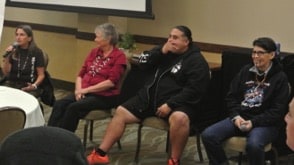
Gifts were presented to speakers and people who helped with the Symposium. The Symposium closed with drawing of raffle prizes and a song.
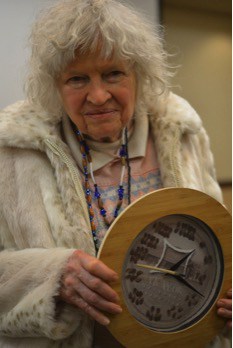

References
Broadbent, Sylvia. The Southern Sierra Miwok Language. University of California Press, 1964.
Callaghan, Catherine. A Grammar of The Lake Miwok Language. University of California Press, 1963.
Callaghan, Catherine. Bodega Miwok Dictionary. University of California Press, 1970.
Callaghan, Catherine. Lake Miwok Dictionary. University of California Press, 1965.
Callaghan, Catherine. Northern Sierra Miwok Dictionary. University of California Press, 1987.
Callaghan, Catherine. Plains Miwok Dictionary. University of California Press, 1984.
Callaghan, Catherine. Proto Utian Grammar and Dictionary. De Gruyter Mouton, 2014.
Freeland, L.S. and Broadbent, Sylvia M. Central Sierra Miwok Dictionary. University of California Press, 1960.
Golla, Victor. California Indian Languages. University of California Press, 2011.
https://www.mewuk.com/cultural/language_preservation.htm


